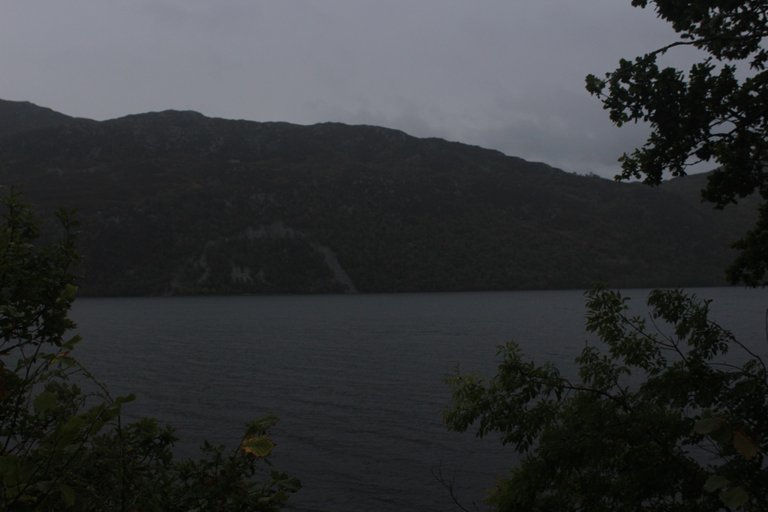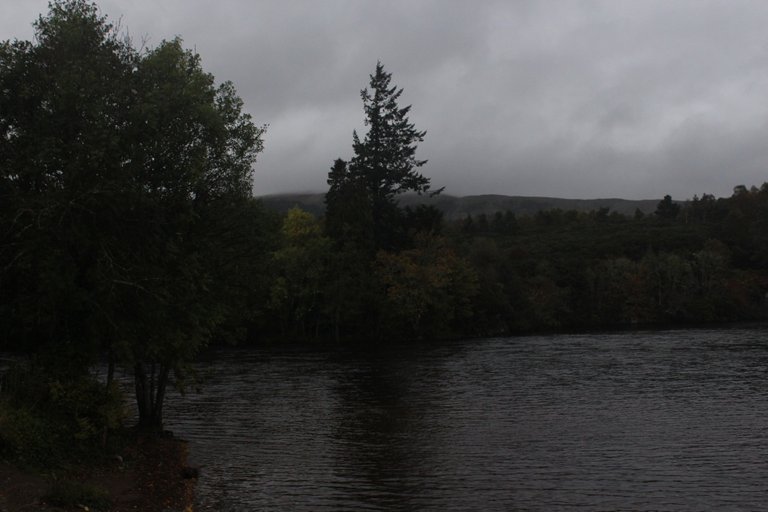Around Scotland no.13 - Loch Ness
[ENG]
The way back from the Scottish Highlands to Edinburgh was very long and we had to divide it into two days. It so happened that the place of our accommodation fell more or less in the vicinity of the town of Inverness, from which it was only a quarter of an hour's drive to Loch Ness, so it was a shame not to take advantage of this opportunity and not stop for the night at this famous lake shrouded in mystery . Loch Ness is the second largest lake in Scotland, but the first largest lake in terms of the amount of water that is in it, and it's all due to the incredible depth of the lake, which is up to 230m at its maximum. The shape of the lake is very characteristic because it is very long and very narrow. (the length of the lake is 37 kilometers, and its greatest width is only 1.5 kilometers). The lake is located in the Great Glen tectonic line stretching from Inverness to Fort William, which was formed during the last ice age. There are several other lakes along the tectonic line beyond Loch Ness, which have been connected to each other by the Caledonian Canal connecting the east and west coasts of Scotland.
[PL]
Droga powrotna z szkockiego Highlands do Edynburgu była bardzo długa i musieliśmy sobie ją podzielić na dwa dni. Tak się złożyło, że miejsce naszego noclegu wypadało mniej więcej w okolicy miejscowości Inverness, z którego to był już tylko kwadrans jazdy nad jezioro Loch Ness, wiec wstyd było nie skorzystać z tej okazji i nie zatrzymać się na noc właśnie nad tym słynnym owianym tajemnicą jeziorem. Loch Ness jest drugim największym jeziorem w szkocji, ale pierwszym największym jeziorem pod względem ilości wody, która się w nim znajduje, a to wszystko za sprawą niebywałej głębokości jeziora wynoszącej w miejscu maksymalnym aż 230m. Kształt jeziora jest bardzo charakterystyczny bo jest ono bardzo długie i bardzo wąskie. ( długość jeziora to 37 kilometrów, a jego największa szerokość to zaledwie 1,5 kilometra). Jezioro jest położone w linii tektonicznej Great Glen rozciągającej się od Inverness do Fort William, która została uformaowana podczas ostatniej epoki lodowcowej. Wzdłuż linii tektonicznej poza jeziorem Loch Ness znajduje się jeszcze kilka innych jezior, które zostały połączone ze sobą Kanałem Kaledońskim łączącym wschodni i zachodni brzeg Szkocji.
[ENG]
The truth is, however, that a dog with a lame leg would not look over Loch Ness if it were not for the world-famous rumor about a monster allegedly inhabiting this loch. The lake, compared to other Scottish lakes, does not stand out in terms of landscape values, and its location attracts more because of the transport of goods from east to west than because of tourism, but it is easy to make money. Suffice it to say that Nessie, who is something with a very long neck, lives in the lake, and tourists from all over the world who will visit Scotland will also look at this seemingly not very interesting corner. It is true that some strange monster inhabits this Scottish lake was said for centuries before the concept of tourism was invented, because already in the 6th century AD, St. Columba became famous for saving one of the villagers from being eaten by a monster that came from the lake. The saint said, I tell you, don't come near and don't touch this man. turn around now! And the monster will not touch a human and will not touch any other human, which made him less dangerous for the environment and even forgotten for the next thousand years. Only in 1658 the traveler Richard Franck in his diaries from his travels around Scotland mentions that on Loch Ness he saw some strange large island covered only with moss floating on the lake. The first serious sighting, during which the observer claimed that he was dealing with something that even philosophers had not dreamed of, was Jimmy Hossak, who saw Nessie in 1862. Since then, the number of sightings of the strange creature began to grow exponentially. The problem is that according to some, the monster resembled a huge crawling caterpillar, and in the opinion of others it had 4 huge elephant legs and barked. Sometimes the creature swam in a zigzag, sometimes straight. Sometimes he stuck his head out of the water and sometimes only his humped back. Things cleared up a bit in 1933 when on November 12, a resident of the town of Foyers, Hugh Gray photographed what he believed was a supposed monster living in the depths of Loch Ness. The photo was reprinted in the Scottish press, and no one was able to stop this machine. People flocked to Loch Ness and, equipped with cameras and cameras, hid on the shores of the lake, waiting for a chance to observe the monster. I suspect many of these sightings weren't there, but after a whole weekend in the bushes, it's embarrassing to just go back to Inverness and tell friends that the whole weekend was wasted here, so the number of sightings went up and up. Over time, when photographing and filming equipment became of better and better quality, it turned out that much of the evidence for the existence of the monster had been fabricated, and the real end to the monster was put by the era of ubiquitous mobile phones. Since then, no one can come back from the lake and say that they saw the monster, because they will immediately be asked for evidence in the form of a recording or at least a photo, and it's not that easy. So cell phones contributed to the slow death of the Loch Ness Monster.
[PL]
Prawda jest jednak taka, że pies z kulawą nogą nie zajrzałby nad Loch Ness gdyby nie słynna na cały świat plotka o potworze rzekomo zamieszkującym to jezioro. Jezioro na tle innych szkockich jezior wcale nie wyróżnia się pod względem walorów krajobrazowych, a jego położenie bardziej przyciąga przyciągałoby z uwagi na transport towarów ze wschodu na zachód niż z uwagi na turystykę, ale żeby pieniądz się kręcił to nic prostszego. Wystarczyło powiedzieć, że w jeziorze mieszka Nessie, która jest czymś co ma bardzo długa szyję, a już turyści z całego świata, który będą odwiedzać Szkocję będą zaglądać również w ten wydawałoby się niezbyt ciekawy zakątek. Co prawda o tym, że jakiś dziwny potwór zamieszkuje to szkockie jezioro mówiono na wieki przed tym nim powstało pojęcie turystyki, bo już w VI wieku naszej ery św. Kolumba wsławił się uratowaniem jednego z wieśniaków przed pożarciem przez potwora który pochodził z jeziora. Święty powiedział Powiadam ci, nie zbliżaj się i nie tykaj tego człowieka. Zawróć natychmiast! No i potwór nie tkną człowieka i nie tkną już żadnego innego człowieka przez co, stał się mniej groźny dla otoczenia i wręcz zapomniany na kolejny tysiąc lat. Dopiero w 1658 podróżnik Richard Franck w swoich pamiętnikach z podróży po szkocji wspomina, że na jeziorze Loch Ness widział jakąś dziwą wielką wyspę porośniętą wyłącznie mchem pływającą po jeziorze. Pierwszej poważnej obserwacji, podczas której obserwujący stwierdził, że ma do czynienia z czymś co się nawet filozofom nie śniło był Jimmy Hossak, który widział Nessie w roku 1862. Od Tego czasu liczba relacji z widzenia dziwnego stworzenia zaczęła narastać lawinowo. Problem w tym, że według jednych potwór przypominał ogromną pełzającą gąsienice, a w opinii drugich miał 4 ogromne niczym u słonia nogi i szczekał. Czasami stwór pływał zygzakiem, a czasami prosto. Czasami z wody wystawiał głowę a czasami tylko garbaty grzbiet. Trochę wyjaśniło się w roku 1933 kiedy to 12 listopada mieszkanieć miasteczka Foyers, Hugh Gray sfotografował coś, co w jego opinii było domniemanym potworem zamieszkującym głębiny jeziora Loch Ness. Zdjęcie przedrukowano w szkockiej prasie no i już tej machiny nikt nie był w stanie powstrzymać. Ludzie tłumnie zjeżdżali się nad Loch Ness i wyposażeni w aparaty fotograficzne oraz w kamery chowali się nad brzegiem jeziora w oczekiwaniu na szansę obserwacji potwora. Podejrzewam, że wiele tych obserwacji nie było, ale po całym weekendzie spędzonym w krzakach wstyd tak po prostu wrócić do Inverness i powiedzieć znajomym, że właśnie oto zmarnowało się cały weekend, więc liczba obserwacji rosła i rosła. Z czasem, gdy sprzęt do fotografowania i filmowania stawał się coraz lepszej jakości okazywało się, że wiele z dowodów na istnienie potwora było spreparowane, a prawdziwy kres potworowi zadała era wszech dostępnych telefonów komórkowych. Od tego czasu nikt już nie może wrócić znad jeziora i powiedzieć, że widział potwora, bo od razu zostanie poproszony o dowód w postaci nagrania lub przynajmniej zdjęcia, a to już nie takie proste. Tak wiec telefony komórkowe przyczyniły się do powolnej śmierci potwora z Loch Ness.







Congratulations, your post has been added to Pinmapple! 🎉🥳🍍
Did you know you have your own profile map?
And every post has their own map too!
Want to have your post on the map too?
Hiya, @LivingUKTaiwan here, just swinging by to let you know that this post made it into our Honorable Mentions in Daily Travel Digest #1760.
Your post has been manually curated by the @pinmapple team. If you like what we're doing, please drop by to check out all the rest of today's great posts and consider supporting other authors like yourself and us so we can keep the project going!
Become part of our travel community:
https://twitter.com/1161422411780304896/status/1615065700111974403
The rewards earned on this comment will go directly to the people( @pl-travelfeed ) sharing the post on Twitter as long as they are registered with @poshtoken. Sign up at https://hiveposh.com.
Congratulations @olusiu! Your post made the TravelFeed team happy so we have sent you our big smile. Keep up the good job. 😃
Thanks for using TravelFeed!
@for91days (TravelFeed team)
PS: You can now search for your travels on-the-go with our Android App. Download it on Google Play